Abstract
The purpose of this study was to investigate joint kinematics of the kicking leg in Taekwondo and to examine the role of inter-joint coordination of the leg in producing the kicking velocity. A new inter-joint coordination index that encompasses three- dimensional hip and knee motions, was defined and applied to the joint kinematic results. Twelve elite Taekwondo athletes participated in this study and performed the back kick, thrashing kick, turning-back kick and roundhouse kick. Our results indicate that the back kick utilized a combination of hip and knee extension to produce the kicking velocity, and was characterized by a pushlike movement. The thrashing kick and turning-back kick utilized a greater degree of hip abduction than the roundhouse kick and back kick, and included complicated knee motions. The new index successfully categorized the thrashing kick and turning-back kick into a push-throw continuum, indicating a change from negative index (opposite direction) to positive index (same direction) of hip and knee motions at the end of the movement. This strategy of push-throw continuum increases the kicking velocity at the moment of impact by applying a throwlike movement pattern.
Key points.
A variety of Taekwondo kicks have unique inter-joint coordination of the kicking leg.
The back kick used a combination of hip and knee extension to produce the kicking velocity, and was characterized by a pushlike movement.
The new index explained well the inter-joint coordination of three DOF joint motions of two joints in producing kicking velocity (positive values for throwlike movements and negative values for pushlike movements).
The index successfully categorized the thrashing kick and turning-back kick into a push-throw continuum.
Key words: Taekwondo, kicks, kinematics, inter-joint coordination
Introduction
Taekwondo, a Korean martial art, is characterized by diverse kicking techniques. Competitive Taekwondo athletes use kicking more often than punching in competition (Kim, 1987), probably because kicking allows a wide variety of attacks and counterattacks to be completed in a single bout (Bae, 1990; Falco et al., 2009; Gang and Lim, 2009; Ha et al., 2008; Hermann et al., 2008; Kim et al., 2010; Kim and Shin, 2000; O’Sullivan et al., 2009; Sorensen et al., 1996; Tang et al., 2007). A series of kicks (Shin et al., 1998; Koo, 2002) may be performed while remaining at a greater distance from the opponent, and kicking provides greater impact forces than punching. The loud impact sounds created by kicks also help judges to determine when points should be granted, making kicks are more advantageous than punches in scored competitions.
Although there are many types of Taekwondo kicks, only a handful are frequently used in sparring, with the roundhouse kick (dollyochagi) being the most popular. Lee, 1998 demonstrated that the roundhouse kick constituted 50% of all kicks for male combatants. In addition, 89% of all points scored in competition are granted for roundhouse kicks. The back kick (dwichagi) is occasionally used as a counterattack or in combination with the roundhouse kick. The thrashing kick (huryochagi) and turning-back kick (dwihuryochagi) are rarely used in Taekwondo sparring but instead are used to knock down an opponent in a bout (Kim, 1987). Compared to the roundhouse kick, the joint kinematics of the back kick, thrashing kick, and turning-back kick have not been thoroughly studied.
In order to execute successful Taekwondo kicks, the inter-joint coordination of the kicking leg is critical. Previous studies classified Taekwondo kicks into throwlike movements and pushlike movements according to qualitative examination of the inter-joint motion of the hip and knee of the kicking leg (Kim, 1993; Kang, 1998). The front kick and roundhouse kick consist mainly of throwlike movements, defined as hip flexion followed by knee extension. The side and back kicks are characterized by pushlike movements in which hip extension and knee extension occur simultaneously at the moment of impact. However, the categorization of the thrashing kick and turning-back kick remains unclear due to the complicated inter-joint coordination of the kicking leg.
The intra-limb coordination (i.e., inter-joint coordination) has been subjected to measures of relative phasing between proximal and distal joints within a limb (Buchanan, 2004; Kelso et al., 1991; Li et al., 2005). Relative phase is represented by one relative joint angle and the direction of angular joint velocities. For example, when describing coordinating wrist flexion with elbow flexion and wrist extension with elbow extension, Li et al., 2005 used “isodirectional mode” and Buchanan, 2004 used “same direction.” On the contrary, “non-isodirectional mode” and “opposite direction” are used for coordinating wrist flexion with elbow extension and wrist extension with elbow flexion. However, this approach is limited only to the planar motions of two joints. The hip or shoulder have three degrees of freedom (DOF) each in three-dimensional space, so that it is impossible to define one relative joint angle with the knee or elbow and the direction of the resultant angular velocity. Therefore, a new approach encompassing three DOF motions is necessary to describe inter-joint coordination of proximal and distal joints in three-dimensional space.
The aims of this study were: 1) to investigate the three-dimensional joint kinematics of the back kick, thrashing kick, and turning-back kick together with the roundhouse kick (Figure 1); and 2) to investigate the inter-joint coordination of the kicking leg in producing kicking velocity in terms of a new index of inter-joint coordination (IIC). We hypothesized that kicks having simple joint kinematics and inter-joint coordination would produce a higher kicking velocity than those having complicated joint kinematics and inter-joint coordination.
Figure 1.
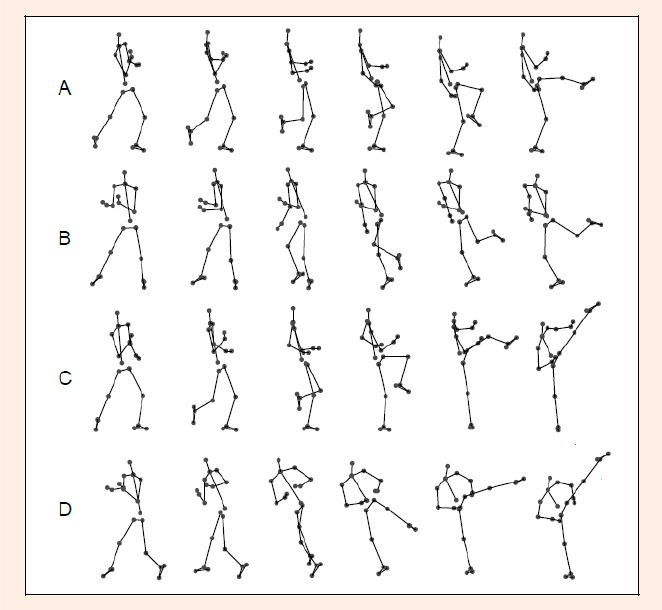
Sagittal view of four Taekwondo kicks: A. Roundhouse kick, B. Side kick, C. Thrashing kick, and D. Turning-back kick.
Figure 2.
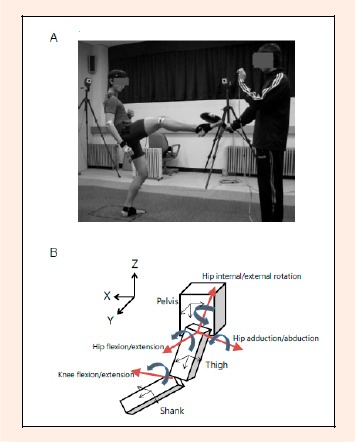
Experimental setup (A) and kinematic model of the hip and knee joints (B).
Methods
Participants
According to power analysis for one-way repeated measure analysis of variance (ANOVA) with our previous pilot study, we got an estimated sample size of nine participants for the conditions of 80% power to detect eta-squared (i.e., effect size) of 0.55 to 0.87. This estimate was based on the detectable difference of 1.0, minimum correlation of 0.8, and alpha ( ) of 0.05 for four treatment conditions (Vonesh and Schork, 1986). We allowed that twelve male Taekwondo athletes voluntarily participated in this study. All participants (age: 20.4 ± 8.4 years, weight: 71.9 ± 8.4 kg, and height: 1.80 ± 0.04 m [mean ± SD]) had practiced Taekwondo for more than seven years (10.6 ± 3.2 years) and all had black belts. All participants were free of neurological or musculoskeletal deficits and had normal vision. Prior to the experiment, they signed consent forms approved by the Kyung Hee University Institutional Review Board. This study followed the policy statement with respect to the Declaration of Helsinki.
Experimental set-up
Full body kinematics, sampled at 200 Hz, were obtained using a six-camera motion analysis system (Hawk® Digital Real Time System, Motion Analysis System, Santa Rosa, CA, USA). Recent studies on Taekwondo have used sampling rates ranging from 60 Hz to 200 Hz (Favarini et al., 2007; Hermann et al., 2008; Kim et al., 2010; Osullivan et al., 2009) to investigate general kinematics of kicks. In addition, other studies on fast limb movements such as tennis strokes (Tanabe and Ito, 2007) and soccer instep kick (Katis and Kellis, 2010) sampled images by the rate of 200 frames per second. The rate of 200 Hz indicates that the resolution of images was 0.005 second, which is appropriate to describe general kinematics patterns during the kick because this study did not include impact analysis.
A 15-component link-segment model, consisting of 29 reflective markers, was used to quantify the motions of the lower extremities. Those markers were attached to the following anatomical landmarks of the lower limbs and trunk: heel, medial and lateral malleoli, lateral femoral condyle, thigh, shank, anterior superior iliac spine, posterior superior iliac spine, and greater trochanter. The toe and medial femoral condyle markers were removed after static motion capture to facilitate dynamic kicking movement. The target was a hand-held kicking pad (All-Star®, Tae Hwa Sports, Seoul, Korea). An assistant held the target with one hand and a custom-made red light-emitting diode (LED) with the other hand (Figure 2A). This LED was designed to provide a triggering signal so that the subject would know when to kick. It was placed above the target (roundhouse kick and back kick) or below the target (thrashing kick and turning-back kick) according to the target height. Two different target heights, depending on the type of kick, were defined. The target was set at abdomen level for the roundhouse kick and back kick, and high for the thrashing kick and turning-back kick. One reflective marker was placed on the target in order to determine the onset of the foot contact to the target.
Body fixed frames were identified in accordance with the recommendation of the International Society of Biomechanics (Wu et al., 2002). The kinematic model of the lower body consisted of the pelvis, thigh, and shank of the kicking leg (Figure 2B). Three DOF of the hip such as flexion/extension, abduction/adduction, and internal/external rotation were considered. Only flexion/extension of the knee was considered due to limited motions of the other DOFs (e.g., valgus/varus and internal/external rotation).
Experimental procedure
When participants came to laboratory, the warm-up was allowed to them until they felt comfortable kicking movements. The routine warm-up followed their own preferred method of stretching and performance of practice kicks. All these procedures ranged from 10 to 15 minutes. After warm-up, participants stood in a fighting stance with the dominant foot back and oriented themselves toward the red LED. No bounce was allowed during preparation and there was no audio instruction or command. They were asked to execute a kick immediately after the onset of the LED flashing and to hit the given target as fast as possible with the bare foot of their dominant leg. To prevent the participant from initiating kicking before the LED signal, the investigator randomly triggered the LED light. Each subject executed the four different kicks in a random order. For each type of kick, three trials were performed and a two-minute break was given before collecting data on the next type of kick.
Data analyses
Kinematic analysis was conducted with a customized Matlab® (The MathWorks™, Natick, MA, USA) software program. Among the three trials, one was selected to indicate the median value of the response time for each subject. The raw data of the marker positions were filtered by a zero-lag second-order Butterworth filter (cutoff frequency 8 Hz). Filtered data were used to construct segment fixed frames (i.e., local coordinate system) to calculate direction cosines with respect to the global coordinate system. The calculation of hip angles followed the joint coordinate system (Grood and Suntay, 1983). Three-dimensional segmental angular velocity and joint angular velocity relative to the global coordinate system were calculated sequentially (Zatsiorsky, 1998).
The kicking time was defined as the period from the onset of toe-off to target contact. The toe-off time was determined when the vertical component of the toe marker exceeded the mean value plus three standard deviations of the vertical height of the toe marker during the preparation period. The moment of foot contact with the target was determined by the onset of the movement of the target marker on the pad. This kicking time was normalized using time normalization procedures for simultaneous comparison between subjects. The kicking velocity was defined as the magnitude of the resultant linear velocity of the toe marker of the kicking leg. We examined the peak kicking velocity during kicking and the impact kicking velocity at the moment of foot contact.
The IIC was calculated using the scalar product (dot product) between three-dimensional unit vectors of hip (ωH) and knee (ωK) joint angular velocities as follows: IIC = (ωH/|ωH|) (ωK/|ωK|) (1) ωH and ωK were the resultant joint angular velocities including three orthogonal angular velocity components. The reason why the normalized angular velocities (ωH /|ωH | and ωK /|ωK |) was intended for readers to understand the index easily because this index focused directions of two joint motions and showed relative contribution of joint motions to the pure planarity condition (1 or -1). Without normalized angular velocities, the resultant dot product would vary in large range of values and there would be no limit of the value to interprete. When the directions of ωH and ωK are parallel, the index will be either 1 (isodirectional mode or same direction) or -1 (non-isodirectional or opposite direction). If the planes of motion of ωH and ωK are not coincident because of other motions of the hip (e.g., abduction and adduction or/and internal and external rotation), the index will be between -1 and 1. Namely, positive IIC (0 < IIC < 1) primarily coordinates hip flexion with knee extension or hip extension with knee flexion with other hip motions. Negative IIC (-1 < IIC <0) dominantly coordinates hip flexion with knee flexion or hip extension with knee extension during kicking motions with other hip motions. Thus, this index indicates how much the motion planes of the hip and knee coincide (i.e., close to absolute value of 1) as well as the relative phase of hip and knee motions (i.e., positive value vs. negative value).
Statistical analysis
A one-way repeated measure ANOVA on kinematic variables was performed using SPSS 12.0 statistical software (SPSS, Chicago, IL, USA). The family-wise error rate was 0.05. Bonferroni’s multiple comparison test was performed as a post hoc process. When the sphericity assumption was violated, the Huynh-Feldt adjustment was applied to adjust the degrees of freedom.
Results
Kinematics of taekwondo kicks
Table 1 illustrates results of the main effects of the types of kicks on kinematic variables. Even though there seemed large deviations of standard deviation between levels in some variables, no significant violation of sphericity assumption was detected by Mauchly’s test. The kicking times of the thrashing kick (0.4 s) and turning-back kick (0.36 s) were longer than those of the roundhouse kick (0.26 s) and back kick (0.27 s) [F(3,33) = 45.1, p < 0.01] (Table 1). The roundhouse kick showed the highest peak kicking velocity (14.7 m·s-1) of all kicks [F(3,33) = 56.0, p < 0.01]. For the validity of this study, the result of the roundhouse kick was compared to results of previous other studies. The kicking time of this study (0.26 s) was a little bit longer than Falco et al., 2009’s result (0.23 to 0.24 second for athletes) and consequently the peak kicking velocity of the roundhouse kick (14.7 m·s-1) was somewhat less than results of Tang et al., 2007 (17.6 m·s-1) and O’Sullivan et al., 2009 (17.7 m·s-1). These differences might be attributed to different groups of participants and different experimental conditions.
Table 1.
Comparison of kinematic variables in different types of Taekwondo kicks. Data are means (±SD).
| Roundhouse kick (RH) |
Back kick (BA) |
Thrashing kick (TH) |
Turning back kick (TB) |
Mauchly’s sphericity test |
F | p | Multiple comparison |
|
|---|---|---|---|---|---|---|---|---|
| Kicking time (s) | .26(.01) | .27(.06) | .40(.06) | .36(.04) | .100 | 45.1 | .001 | TH=TB>RH=BA |
|
Peak kicking velocity (m·s-1) |
14.7(1.3) | 11.5(1.0) | 9.9(1.3) | 11.4(1.2) | .941 | 56.1 | .001 | RH>BA=TB>TH |
|
Impact kicking velocity (m·s-1) |
10.6(1.6) | 6.2(1.6) | 5.7(1.7) | 9.7(1.7) | .199 | 31.3 | .001 | RH=TB>BA=TH |
| Hip flexion/extension ROM (°) | 56.6(9.6) | 52.7(13.6) | 76.8(13.2) | 56.1(10.2) | .230 | 13.2 | .001 | TH>RH=BA=TB |
|
Hip abduction/ adduction ROM (°) |
26.3(9.1) | 33.3(10.4) | 54.2(7.2) | 58.6(5.4) | .613 | 54.5 | .001 | TH=TB>RH=BA |
| Hip internal/external rotation ROM (°) | 37.1(7.9) | 17.5(4.3) | 39.3(11.0) | 25.0(8.3) | .094 | 18.4 | .001 | TH>TB>BA,& RH>BA |
|
Knee flexion/ extension ROM (°) |
95.5(11.3) | 97.0(7.5) | 96.5(18.1) | 81.2(12.1) | .053 | 4.8 | .007 | BA=TH>TB |
The peak velocity of the thrashing kick (9.9 m·s-1) was less than that of the back kick (11.5 m·s-1), but there was no difference in the impact velocities (5.7 m·s-1 and 6.2 m·s-1 for thrashing kick and back kick, respectively). Figure 3 shows changes in kicking velocity according to the normalized kicking time. Both the thrashing kick and turning-back kick exhibited a rebound in kicking velocity at the end of the movement.
Figure 3.
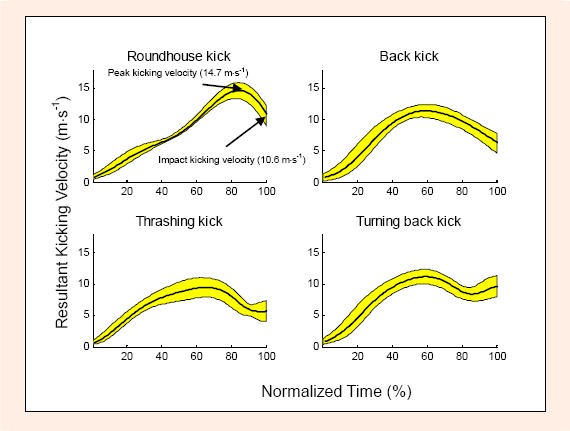
Time-transient profiles of kicking velocities for the four different kicks. The thick line shows kicking velocity profiles averaged across all subjects. The shaded area indicates the standard deviation.
The angular kinematics explain the qualitative characteristics of each type of kick (Figure 4). The roundhouse kick consisted of simple and monotonic changes in hip motions (hip flexion, internal rotation, and abduction) with knee flexion and extension. The back kick primarily showed hip flexion, adduction, and knee flexion first, followed by hip extension, abduction, and knee extension. A few changes in the hip rotation angle were detected. The thrashing kick showed a similar pattern to the back kick but it terminated with a slight knee flexion and a large hip abduction. The turning-back kick ended with hip extension with slight knee flexion. The knee motion was very complicated across the normalized time. Quantitative and statistical results are shown in Table 1. In terms of the hip flexion and extension angles, the thrashing kick (76.8°) showed the highest range of motion (ROM) [F(3,33) = 56.0, p < 0.01]. The ROMs of hip abduction for the thrashing kick (54.2°) and turning-back kick (58.6°) were significantly larger than those of the roundhouse kick (26.3°) and back kick (33.3°). The back kick (17.5°) indicated the lowest ROM of hip rotation and the turning-back kick (81.2°) revealed a lower ROM of knee flexion/extension than any other kick.
Figure 4.
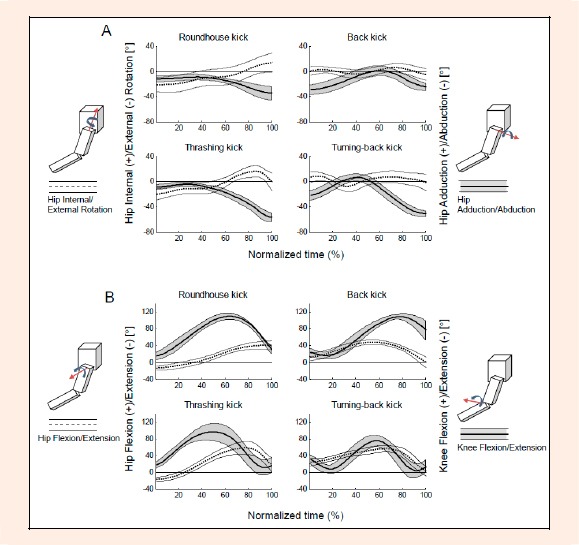
Time-transient profiles of joint angles of the hip and knee: A. Hip internal rotation/external rotation and hip abduction/adduction, and B. Hip flexion/extension and knee flexion/extension.
Index of inter-joint coordination (IIC)
Figure 5 shows time-transient IICs for the four different kicks. The IIC of the roundhouse kick remained close to -0.75 (non-isodirectional mode or opposite direction due to coordination of hip flexion with knee flexion) until halfway through the normalized kicking time when the IIC value became positive and remained constant at 0.5 (isodirectional mode or same direction due to coordination of hip flexion with knee extension) after 70% of the normalized kicking time. However, the other kicks showed fluctuating IIC values during the normalized kicking time. Both the thrashing kick and turning-back kick ended with positive IIC after transitioning from negative values before the end of movement. These results were mainly attributed to coordinated hip extension with knee extension (negative IIC) and immediately followed by hip extension with knee flexion (positive IIC) right before impact. Increased hip abduction angles in the thrashing kick and turning-back kick reduced the quality of co-planarity of the hip and knee joint motions and consequently induced lower magnitude IICs in the middle of the normalized kicking time. The back kick maintained a non-isodirectional mode primarily by coordinating hip extension with knee extension after 77% of the normalized kicking time.
Figure 5.
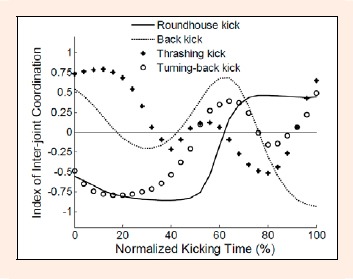
Time-transient indices of inter-joint coordination for the four different kicks.
Discussion
The purpose of this study was to investigate the three-dimensional joint kinematics for different types of Taekwondo kicks, including the back kick, thrashing kick, and turning-back kick in addition to roundhouse kick. Through joint kinematics analysis, we found that the back kick primarily depended on flexion/extension of the hip and knee joints (sagittal plane motion) while minimizing hip rotation (transverse plane motion) and abduction/adduction (frontal plane motion) generating the kicking velocity. If the decent amount of ranges of motion is allowed to hip internal/external rotation and/or abduction/adduction, the shorter kicking time (0.27 s) than the turning back kick (0.36 s) could not be guaranteed due to more involvement of other DOFs. Thus, the back kick has an advantage of the kicking time with minimizing other plane motions than sagittal plane. However, when the foot was about to the target, the joint configuration would be inevitably heading to the anatomical limits (i.e., full extensions of hip and knee), which was characterized by gradually reduced kicking velocity after 58.4% of the normalized kicking time. The thrashing kick and turning-back kick overcame the drop in velocity by executing hip extension and knee flexion right before impact. This inter-joint motion accounted for the rebound in kicking velocity in these two types of kicks (Figure 3). Therefore, the impact velocity of the turning-back kick was close to that of the roundhouse kick despite the high target location and complicated knee motions. Both the thrashing kick and turning-back kick inevitably used large hip abductions in order to hit the high target. Definitely all the possible degrees of freedoms of hip motion could contribute to the kicking speed and power positively or negatively, depending on coordination with other joint(s) and anatomical limits of ranges of motion.
The newly-defined IIC proved to be a good index for describing the inter-joint coordination of the hip and knee joints of the kicking leg, especially including three DOFs of joint motions. First, the IIC clearly discriminated movement patterns between throwlike movements and pushlike movements that produced the distal end velocity differently before impact. The throwlike movements of the roundhouse kick ended with isodirectional mode or “same direction” of hip and knee motions (positive IIC) (Putnam, 1991), while the pushlike movement of the back kick ended with non-isodirectional mode or “opposite direction” (negative IIC) (Kang, 1998; Kim, 1993). The thrashing kick and turning-back kick showed negative IICs (non-isodirectional mode) at later part of kicking that turned to positive IICs (isodirectional mode) right before impact. This implied that these two kicks tried to overcome the reduction in velocity by applying the strategy of the throwlike movement (positive IIC) at the end of kicking. Therefore, these two kicks could belong to a new category of movement patterns used to generate the kicking velocity, the push-throw continuum motion. Second, this index indirectly described the contribution of other DOF motions (internal/external rotation and adduction/abduction) than flexion/extension at the hip. When considering the joint angle profiles of the hip and knee motions together, we found that large hip abductions and rotations induced non-co-planar motions between hip and knee joint motions and consequently produced lower magnitudes of IIC.
In addition, this IIC could help to understand other kinematic results of kicking and tactics of kicking. For example, throwlike movements (e.g., the roundhouse kick) and pushlike movements (e.g., the back kick) indicated fewer numbers of local minimum and maximum in IIC curves than push-throw continuum IIC curves, so that significantly shorter kicking times were detected in the roundhouse kick and back kick. However, the simple trajectory of the foot created by simple inter-joint coordination would be easily tracked by a defender. The push-throw continuum, showing a complex curve of IIC due to multiples of local minimum and maximum, would provide a defender with the difficulty of tracking the trajectory of the foot. But it could be compensated by a longer kicking time of push-throw continuum kicks.
There are three limitations to this study. First, we excluded ankle joint kinematics from study because the analysis was limited to only two joint motions. If the motions of the ankle (plantar flexions for the roundhouse kick, thrashing kick, and turning-back kick and dorsal flexion for the back kick) contribute to the kicking velocity, they would also affect inter-joint coordination. Second, we did not standardize the height of the target across four different kicks. Thus, the large magnitude of the hip abduction angle and kicking time in the thrashing kick and turning-back kick were partially attributed to the different heights of the target in different trials (Falco et al., 2009). Finally, the higher sampling rate (more than 200 Hz) would be better for rapid kicking movement because the larger deviations of kinematic results detected in this study across all participants should be carefully used to generalize the data.
Conclusion
This study illustrated joint kinematics of the kicking leg for poorly-documented Taekwondo kicks such as the back kick, thrashing kick, and turning-back kick. The pushlike movement of the back kick produces kicking velocity primarily via hip extension and knee extension while minimizing hip rotation and abduction. The thrashing kick and turning-back kick use a different strategy of inter-joint coordination, which we call “push-throw continuum,” for generating the kicking velocity. This enabled a rebound in kicking velocity to overcome the deficiency of the pushlike movement. Our newly-defined IIC is a useful index to describe inter-joint coordination created by three DOF motions between adjacent joints in three-dimensional space. This index well explained why the inter-joint coordination of the roundhouse kick is advantageous to producing fast kicking velocity and quick kicking time.
Acknowledgments
This research project was supported by the Sports Promotion Fund of Seoul Olympic Sports Promotion Foundation from Korean Ministry of Culture, Sports and Tourism, and National Agenda Project (NAP) funded by Korea Research Council of Fundamental Science and Technology (P-09-JC-LU63-C01). Also it was partially supported by a grant from the Kyung Hee University in 2010 (KHU-20101372)
Biographies

Young Kwan Kim
Employment
Research Professor, Department of Mechanical Engineering, Kyung Hee University, Korea.
Degree
PhD.
Research interests
Sports biomechanics, multi-joint motor control/learning.
E-mail: ykkim01@khu.ac.kr

Yoon Hyuk Kim
Employment
Associate Professor, Department of Mechanical Engineering, Kyung Hee University, Korea.
Degree
PhD.
Research interests
Musculoskeletal biomechanics.
E-mail: yoonhkim@khu.ac.kr
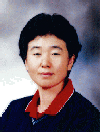
Shin Ja Im
Employment
Assistant Professor, Department of Taekwondo, Kyung Hee University, Korea.
Degree
PhD.
Research interests
Sport psychology of Taekwondo athlete, Development of sparring technique.
E-mail: imsj01@hotmail.com
References
- Bae Y.S. (1990). Biomechanical study on Dolreochagi of Taekwondo. Korean Journal of Physical Education 229 ,, 277-293 (In Korean) [Google Scholar]
- Buchanan J.J. (2004) Learning a single limb multijoint coordination pattern: the impact of a mechanical constraint on the coordination dynamics of learning and transfer. Experimental Brain Research 156, 39-54 [DOI] [PubMed] [Google Scholar]
- Falco C., Alvarez O., Castillo I., Estevan I., Martos J., Mugarra F., Iradi A. (2009) Influence of the distance in a roundhouse kick’s execution time and impact force in Taekwondo. Journal of Biomechanics 442, 242-248 [DOI] [PubMed] [Google Scholar]
- Favarini R.A., Pereira B.M., de Moraes J.H., Monteiro A.D., de Souza A.M., Menzel H.-J., Chagas M.H. (2007) Cinematic analysis during a kick of Taekwondo after passive static stretching exercise. In: Proceedings of XXV International Conference on Biomechanics in Sports. : Menzel H.-J., Chagas M.H.Ouro Preto, Brazil: Federal University of the State of Minas Gerais; 598-601 [Google Scholar]
- Gang G.-H., Lim J.-N. (2009) Analysis of motion in the Taekwondo Kyorugi players effective Dwihuryo-chagi. Journal of Korean Alliance of Martial Arts 111, 263-274 (In Korean) [Google Scholar]
- Grood E.S., Suntay W.J. (1983) A joint coordinate system for the clinical description of three-dimensional motions: application to the knee. Journal of Biomechanical Engineering 105, 136-144 [DOI] [PubMed] [Google Scholar]
- Ha C.-S., Choi M.-H., Kim B.-G. (2008) The kinematical analysis of the Taekwondo sparring players’ Bandal Chagi in kinematics. Korean Journal of Sport Sciences 119, 22-30 (In Korean: English abstract) [Google Scholar]
- Hermann G., Scholz M., Vieten M., Kohloeffel M. (2008) Reaction and performance time of Taekwondo top-athletes demonstrating the Baldung-chagi, In: Proceedings of XXVI International Conference on Biomechanics in Sports. Eds: Kwon Y.-H., Shim J., Shim J.K., Shin I.-S.Seoul, Korea: Seoul National University; 416-19 [Google Scholar]
- Kang S.-C. (1998) Analysis of the patterns of the biomechanical characteristics in Taekwondo kicking techniques. Unpublished doctoral dissertation, Sungkyunkwan University, Seoul, Korea: (In Korean: English abstract) [Google Scholar]
- Katis A., Kellis E. (2010) Three-dimensional kinematics and ground reaction forces during the instep and outstep soccer kicks in pubertal players. Journal of Sports Science 28, 1233-1241 [DOI] [PubMed] [Google Scholar]
- Kelso J. A. S., Buchanan J. J., Wallace S. A. (1991) Order parameters for the neural organization of single, multijoint limb movement patterns. Experimental Brain Research 883, 432-444 [DOI] [PubMed] [Google Scholar]
- Kim H.-W. (1987) A inquiry and analysis to attack skills in Tae Kwon Do game. Korean Journal of Physical Education 226, 125-139 (In Korean) [Google Scholar]
- Kim J.-W., Kwon M.-S., Yenuga S.S.m, Kwon Y.-H. (2010) The effects of target distance on pivot hip, trunk, pelvis, and kicking leg kinematics in Taekwondo roundhouse kicks. Sports Biomechanics 9, 98-114 [DOI] [PubMed] [Google Scholar]
- Km S.-J. (1993) Kinematic classification of Taekwondo kicking techniques. Unpublished doctoral dissertation, Yonsei University, Seoul, Korea: (In Korean: English abstract). [Google Scholar]
- Kim W.-S., Shin S.-H. (2000) A biomechanical analysis of the Abmilechagi Taekwondo technique. Korean Journal of Sport Biomechanics 99, 43-65 (In Korean: English abstract) [Google Scholar]
- Koo H.-S. (2002) An kinematic analysis of Naraechagi Taekwondo technique. Korean Journal of Physical Education 441, 601-613 (In Korean: English abstract) [Google Scholar]
- Kreighbaum E., Barthels K.M. (1990) Biomechanics: A qualitative approach for studying human movement. New York, NY: Wiley [Google Scholar]
- Lee J.-B. (1998) A study of kicking techniques of advanced Korea Taekwondo players. Unpublished coaching report, Korea Institute of Sport Science, Seoul. (In Korean)
- Li Y., Levin O., Forner-Cordero A., Swinnen S.P. (2005) Interactions between interlimb and intralimb coordination during the performance of bimanual multijoint movements. Experimental Brain Research 163, 515-526 [DOI] [PubMed] [Google Scholar]
- O’Sullivan D., Chung C., Lee K., Kim E., Kang S., Kim T., Shin I. (2009) Measurement and comparison of Taekwondo and Yongmudo turning kick impact force for two target heights. Journal of Sports Science and Medicine 8, 13-16 [PMC free article] [PubMed] [Google Scholar]
- Putnam C.A. (1991) A segment interaction analysis of proximal-to-distal sequential segment motion patterns. Medicine and Science in Sports and Exercise 223, 130-144 [PubMed] [Google Scholar]
- Shin S.-H., Yoon D.-S., Lee J.-H., Back J.-H., Lee Y.-J. (1998) A study on kinematic factors of sequential movements in Taekwondo: Apdollyeoachagi and Dolgaechagi techniques. Korean Journal of Physical Education 337, 248-264 (In Korean: English abstract) [Google Scholar]
- Sorensen H., Zacho M., Simonsen E.B., Dyhre-Poulsen P., Klausen K. (1996) Dynamics of the martial arts high front kick. Journal of Sports Sciences 114, 483-495 [DOI] [PubMed] [Google Scholar]
- Tanabe S., Ito A. (2007) A three-dimensional analysis of the contributions of upper limb joint movements to horizontal racket head velocity at ball impact during tennis serving. Sports Biomechanics 6, 418-433 [DOI] [PubMed] [Google Scholar]
- Tang W.T., Chang J.S., Nien Y.H. (2007) The kinematics characteristics of preferred and non-preferred roundhouse kick in elite Taekwondo athletes. Journal of Biomechanics 40(s2), S780 [Google Scholar]
- Vonesh E.F., Schork M.A. (1986) Sample sizes in the multivariate analysis of repeated measurements. Biometrics 42, 601-610 [PubMed] [Google Scholar]
- Wu G., Siegler S., Allard P., Kirtley C., Leardini A., Rosenbaum D., Whittle M., D'Lima D. D., Cristofolini L., Witte H., Schmid O., Stokes I. (2002) ISB recommendation on definitions of joint coordinate system of various joints for the reporting of human joint motion - part I: ankle, hip, and spine. Journal of Biomechanics 335, 543-548 [DOI] [PubMed] [Google Scholar]
- Zatsiorsky V.M. (1998) Kinematics of human motion. Human Kinetics, Champaign, IL [Google Scholar]


